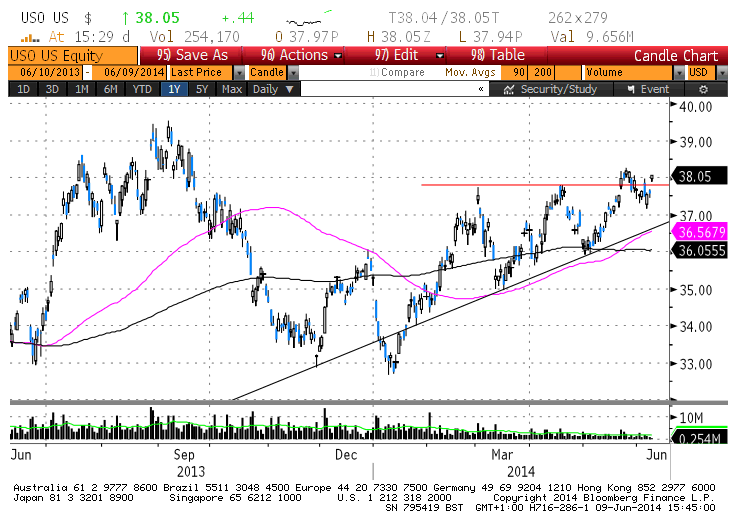Why Bother Looking at Bowleven (code: BLVN.L)?
- Value: A very cheap stock on certain deep value measures: Price/Book Value ratio of 0.4x;
- Value (2): Estimated Net Asset Value per share (BMO, Barclays): 99-135p. Current share price: 40.8p: Price/estimated NAV: 0.3-0.4x;
- Catalyst: Agreement to sell down a 50% interest in its Etinde permit offshore Cameroon for Lukoil and NewAge for a total $250m, giving Bowleven enough cash to finance its share of development capex through to finding first oil (25% share left);
- Revaluation: Offshore Cameroon oil & gas resources worth potentially 70p/share for Bowleven, 71% higher than current share price.
- Technical: BLVN.L share price has bottomed out, now rising steadily, gap to close at 52p.
A Small-Cap in one of my favourite sectors: Oil & Gas
I remain unashamedly keen on the global Oil & Gas sector, with recent Middle Eastern geopolitical worries in Iraq, Syria and Libya keeping the Brent crude oil price at relatively elevated levels, despite the onrush of shale oil production Stateside.
Bowleven (BLVN.L) is a junior oil exploration company (market capitalisation £130m) with development interests offshore Cameroon in Africa.
The Etinde permit, the subject of this latest stake sale to Lukoil and NewAge, comprise 3 blocks MLPH-5, 6 and 7 (Figure 1).
1. Etinde permit, offshore Cameroon
Source: company
While I admit that I am no oil & gas specialist, Bowleven piques my interest as an investor for a number of reasons, despite the rather large stumbling block of being loss-making at present (consensus EPS estimates are pegged at a loss of $0.036 for this year and $0.035 in 2015), which normally rules a company out of consideration for me.
Value: Lots of unexploited value in Cameroonian assets
The stated balance sheet gives a trailing book value per share of $1.82 (Figure 2), which translates to 107p at the current $1.70 exchange rate.
2. Balance sheet shows lots of potential value hidden
This gives a price/book value ratio of just 0.4x, including the $38m of cash already on the balance sheet, before the cash infusions from the stake sale to Lukoil and NewAge.
3. Price Book Valuation Attractive
The stake sale to Lukoil and NewAge is to bring in some $170m initially on completion (in September), plus assigns $80m further cash and carry thereafter dependent on completion of certain milestones (details can be found here).
Taking the $32m on the balance sheet already (as of February) plus the $170m the company is to receive initially amounts to $202m, or £118m which is virtually Bowleven's entire market cap today.
If you add the $80m contingent value from the deal, then we arrive at £166m. Of course, Bowleven is going to spend much of this cash in developing their share of these blocks to hopefully start to produce oil, but this is the situation today.
Value (2): Net Asset Value Estimates of 99p - 135p
Broker research from Barclays and BMO pegs the Net Asset Value (NAV) of Bowleven (prior to this latest deal) at somewheere between 99p (BMO's estimate; Figure 4) and 135p (Barclays' estimate), yielding a price/NAV ratio of 0.3-0.4x.
4. BMO's NAV estimate for BLVN.L
Source: BMO Capital Markets
Now a Takeover Candidate?
With this Lukoil/NewAge deal finally validating Bowleven's oil exploration efforts, could it now even become a takeover target for a larger oil & gas concern? There are plenty of large companies looking to add oil & gas reserves, and Bowleven is now both cash-rich and offers some interesting exploration assets.
Of course, we can ask why Lukoil didn't just buy the entire company, if it was so obvious a deal. This is of course a very good question. Nevertheless, with this deal due to complete in September, something may still happen in this regard... I am certainly not banking on this prospect, but it is a nice free option to have.
Why still so cheap then?
While Bowleven is a retail investor favourite, it has had a very chequered history, culminating in the last rights issue in November 2013 when 29.47m shares were issued at 45p, 10% above the current share price. So current shareholders have certainly suffered over the last few years with this stock, judging by the long-term price chart (Figure 5):
5. Bowleven's Long-Term Price Chart: A Tale of Woe
Source: Bloomberg
Technical View: Solid Uptrend Established, Gap to Fill at 52p
Three things to note on the short-term chart (Figure 6):
- The previous downtrend has been broken;
- A new uptrend has been established;
- There is a gap to fill (from the time of the last share placing in November 2013) at 52p.
6. Bowleven's Short-Term Chart is Encouraging
Source: Bloomberg
Summing it all up: A Speculative Value Opportunity in Oil
Bowleven is certainly speculative, but has an interesting combination of value opportunity, catalyst and positive technicals in a sector that I favour, trading at 41p.
But as always, this is just my view, not an official recommendation by any means, so as always, Do Your Own Research!!
Disclaimer: I do not hold Bowleven shares at present, though may initiate a position in the next 48 hours...






































